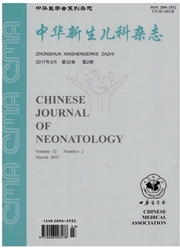

 中文摘要:
中文摘要:
目的 探讨高氧、雷帕霉素干预后未成熟新生鼠肺组织转化生长因子β(transforminggrowth factor-β,TGF-β)、结缔组织生长因子(connective tissue growth factor,CTGF)和胶原蛋白1(collagen 1,COL1)含量变化,以及雷帕霉素靶蛋白(mammalian target of rapamyein,mTOR)通路下游靶蛋白P70S6K和真核启动因子4E结合蛋白1(eukaryotic initiation factor 4E binding protein 1,4EBP1)水平变化,了解高氧肺损伤中mTOR通路的作用及可能的干预方法.方法 选择胎龄21d未成熟新生鼠,分为空气对照组、高氧3d组、高氧7d组、高氧14 d组、空气+雷帕霉素组、高氧3d+雷帕霉素组、高氧7d+雷帕霉素组、高氧14d+雷帕霉素组各6只.高氧组分别暴露在90%浓度氧下3、7、14 d,雷帕霉素组在高氧暴露下腹腔注射雷帕霉素3、7、14 d,空气+雷帕霉素组注射3d,观察不同时间高氧、雷帕霉素干预后新生鼠肺组织病理变化,同时应用酶联免疫吸附法检测肺组织TGF-β、CTGF及COL1蛋白含量,Western blot检测肺组织mTORC1、P70S6K和4EBP1蛋白表达水平.结果 高氧3、7、14 d组肺组织TGF-β[(33.7±2.8)、(58.6±3.1)、(98.8±1.5) ng/mg]、CTGF[(50.1±1.8)、(68.7±2.2)、(94.4±2.5)ng/mg]及COL1[(471.9±5.7)、(529.7±7.0)、(556.4±8.5)ng/mg]含量均高于空气对照组[(25.5±1.9)、(41.7±1.4)、(414.4±8.9)ng/mg,P均<o.01],雷帕霉素干预组含量低于相应时间高氧组(P<0.01).高氧3d、7d+雷帕霉素组肺组织病理评分均较同时间高氧组下降[(3.5±0.8)分比(6.3±2.3)分、(9.7±2.0)分比(14.0±2.4)分,P<0.01].高氧3d+雷帕霉素组mTORC1[(0.26 ±0.04)比(0.29±0.08)]、P70S6K[(0.29±0.01)比(0.31±0.08)]和4EBP1[(0.31 ±0.06)比(0.33±0.06)]蛋白表达均低于高氧3d组(P<0.05),高氧7d、14d+雷帕霉素组表达较3d组下降(P<0.01).结论 mTOR信号通路可能参与高氧肺损伤纤维化修复过程,雷帕霉素能减少TGF-β、CTGF及COL1蛋白表达,抑制mTOR信号通路下游因子P70S6K和4EBP1表达,减轻早期
 英文摘要:
英文摘要:
Objective To study the changes of transforming growth factor-β (TGF-β),connective tissue growth factor (CTGF) and collagen 1 (COL1) in newborn rat's lung tissue and the expressions of 4EBP1 (eukaryotic promoter) and P7OS6K (mammalian target of rapamyein pathway downstream target protein) after rapamycin and hyperoxia intervention,and to study the influence of mammalian target of rapamyein (mTOR) pathway on hyperoxic lung injury and the possible intervention methods.Method A total of 48 21-day-old neonatal rats were assigned into 8 groups (n =6),including air control group,3 d group (3 days after hyperoxic exposure),7 d group (7 days after hyperoxic exposure),14 d group (14 days after hyperoxic exposure),air + RAPA group (air + rapamycin),3 d + RAPA group (3 days after hyperoxic exposure + rapamycin),7 d + RAPA group (7 days after hyperoxic exposure + rapamycin) and 14 d + RAPA group (14 days after hyperoxic exposure + rapamycin).In the hyperoxic group,newborn rats were exposed to 90% oxygen for 3,7,14 days respectively.The rats in the hyperoxia + rapamycin intervention groups received intraperitoneal injection of rapamycin and inhaled high concentrations of oxygen for 3,7,14 days respectively.Air ± rapamycin group received intraperitoneal injection of rapamycin for 3 days.To study the pathological changes of lung tissures after hyperoxia and rapamycin intervention,we used ELISA to detect the changes of TGF-β,CTGF and COL1 and Western blot to detect the variations of mTORC1,P70S6K and 4EBP1 expression.Result TGF-β,CTGF,COL1 levels at 3 days,7 days and 14 days after hyperoxic exposure (TGF-[β:33.7±2.8 vs.58.6 ±3.1 vs.98.8 ±1.5 ng/mg,CTGF:50.1 ±1.8 vs.68.7 ± 2.2 vs.94.4 ±2.5 ng/mg,COL1:471.9 ±5.7 vs.529.7 ±7.0 vs.556.4 ±8.5 ng/mg) were significantly higher than the air control group (TGF-β:25.5 ± 1.9 ng/mg,CTGF:41.7 ± 1.4 ng/mg,COL1:414.4 ± 8.9 ng/mg) (P < 0.01).While the levels in rapamycin intervention group were significantly lower than all the hyperoxia + rapamycin intervention groups (P ?
 同期刊论文项目
同期刊论文项目
 同项目期刊论文
同项目期刊论文
 期刊信息
期刊信息
